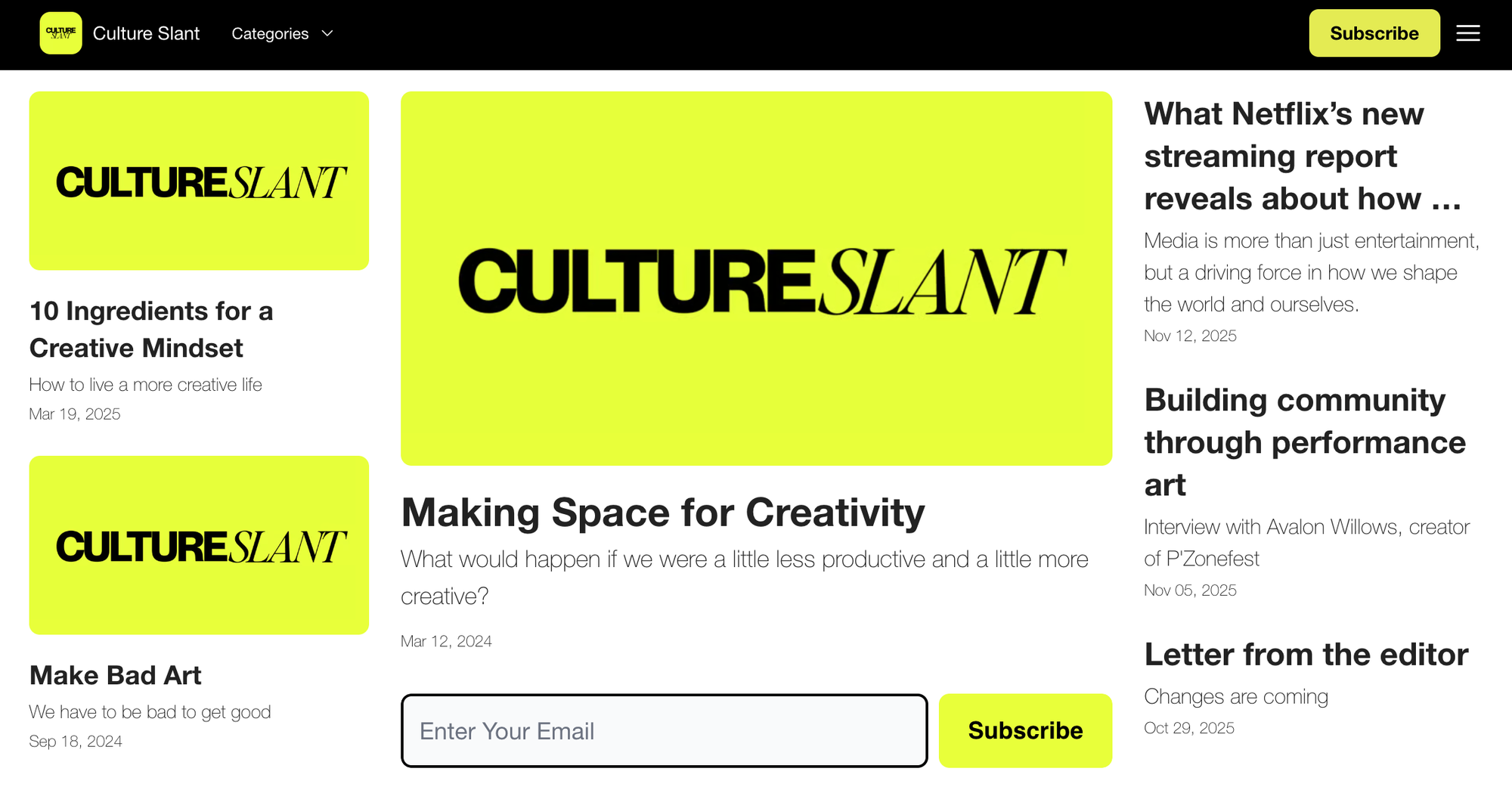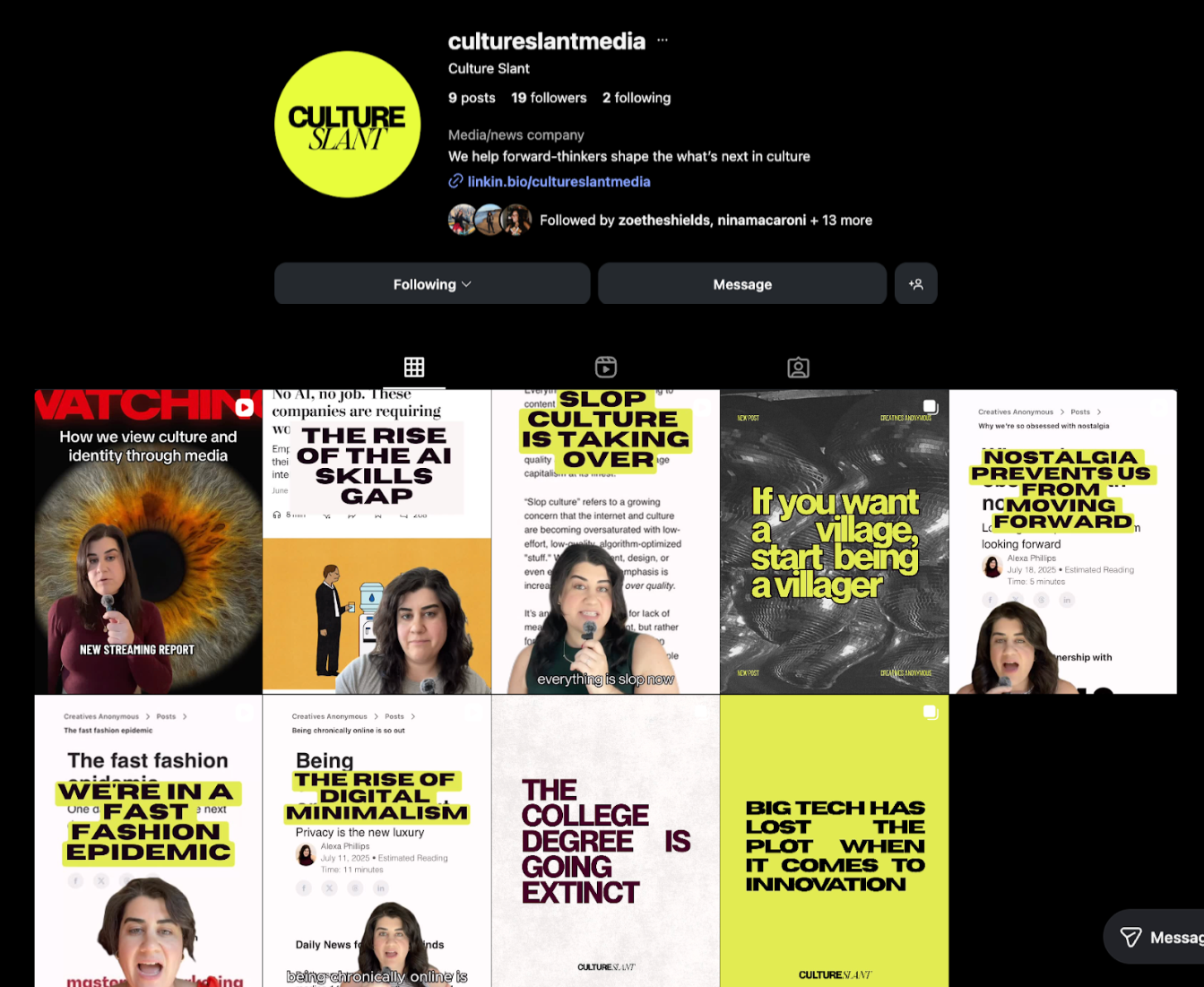Brands are no longer just businesses — they’re cultural media properties that shape taste, conversation, and identity through the content they create.
Which means brands (and entrepreneurs) become the next tastemakers, influencing culture.
And media is the tool that bridges the trust gap between creators and consumers, creating a credible body of work that positions them as authorities.
I was first introduced to the concept of “entrepreneurial journalism” in college. In fact, I took an entire class on it. It’s still being offered today, and my alma mater’s course catalog describes the class as “the concepts and practices of developing media content solutions for the digital age.”
And it is the future of storytelling, brand building, and digital media.
What is entrepreneurial journalism?
I interpret entrepreneurial journalism as knowledge-driven, creator-led storytelling that reaches and engages audiences directly. It’s content creation that blends reporting, education, and cultural interpretation to create long-form content platforms and independent media companies.
With entrepreneurial journalism, the content is the product—you own and control the platform and narrative. The idea with entrepreneurial journalism is to build an owned audience, not a rented one, so you’re building long-form-first content (a newsletter, podcast, YouTube show, or blog), using short-form content to supplement or distribute your main content channel.
This type of media has existed for quite some time, but now that we are at the height of the creator economy, it’s become more prevalent due to a number of factors:
- Trust in traditional media is now. According to a new Gallup poll, trust in traditional media is at an all-time low of 28%, with audiences turning to creators and independent journalists for news and perspectives.
- Layoffs. More outlets are consolidating or closing their doors altogether. Nearly 10,000 journalists have been laid off in the last three years, and more are leaving traditional outlets to go independent (Taylor Lorenz, Derek Thompson, etc.).
- Creator economy boom. Creator economy is projected to surpass $480 billion by 2027, with large enterprises investing an average of $5.6M-$8.1M annually. And for good reason: 61% of consumers trust creator recommendations more than traditional brand ads.
- Privatized content channels. Changes in AI and SEO are driving an increase in private content channels (newsletters, podcasts, membership communities) that deliver higher-quality content than what you can find on Google.
- Shift toward knowledge-driven content. Content is shifting toward education rather than lifestyle-focused content, with creators sharing their expertise with audiences.
What this does is present an opportunity to merge journalistic rigor with creator economy agility to deliver knowledge-driven storytelling that engages, innovates, and remains relevant through independently run media platforms and content ecosystems, creating a new legion of trusted, credible media sources to fill the gap left by brands and media outlets.
Including entrepreneurs.
"It’s not opinion, but rather informed critique and commentary that comes from a place of experience and interpretation backed up by data and facts."
Why entrepreneurial journalism makes sense for entrepreneurs
As an entrepreneur, you’re already an expert in your field. So why not turn it into something more to help you build authority?
Entrepreneurial journalism gives you that.
When you build an editorial media platform, you:
- Position yourself for other career opportunities. Whether it’s speaking, teaching, or writing, a media platform helps you create a body of work that allows you to get paid for your perspective.
- Diversify your revenue. Monetize your media platform through brand partnerships, ads, subscriptions, and more.
- Build trust, authority, and credibility in your industry. Media helps you become a thought leader and the go-to expert on that topic.
- Move beyond offers and become known for your ideas. A media platform lets you explore broader cultural ideas and trends related to what you sell, allowing you to own a topic and perspective.
- Build a brand, not a business. Media helps take you from just being in business to serve clients to starting a movement that inspires, educates, and captivates others.
I started doing this last year with my own media platform, Culture Slant, which began as a newsletter and is now expanding into a media company.
For context, I do content/editorial consulting, but my platform specifically focuses on how media is shaping culture.
Rather than just talking about “how to create a content strategy,” I talk about:
- What streaming media reveals about how we view identity and culture
- Why we need to add more friction
- How F1 The Movie was a masterclass in content marketing for Apple
These topics allow me to follow my curiosity while also tying them back to a larger idea around what I sell.

How to start an entrepreneurial journalism platform
There are five components you need to start building an entrepreneurial journalistic endeavor:
Narrative
Narrative is the most important component of building a media platform. This is the idea that you own and the story that you’re telling. Not to mention, the backbone of your content.
It’s the bigger idea behind what you sell, a topic that speaks to your expertise. It’s also the perspective that you bring. Generic takes from Google or ChatGPT don’t cut it here. It needs to be unique, nuanced, and speak to your experience—the more specific and honed in, the better. But also make it something you’re genuinely curious and passionate about in your area of expertise, because it will make it so much easier to create consistently.
Strategy
You can’t create content without a plan. To create a successful platform, there needs to be a strategy behind it, including:
- The goals you want to get out of the platform—both for you and your audience
- Your audience, including demographics, psychographics, and socialgraphics
- Metrics you’re going to track to measure success
This ensures that you’re making the content work for you in the way that you want it to.
Storytelling Framework
A framework I like to use is “REI,” which stands for “Reporting,” “Experience,” “Insight.”
It creates more “op-ed” focused content that layers what happened (reporting) with education and expertise (experience) in the context of what it means and why it matters (insight).
Think of it as: “Based on X and given my experience/expertise with Y, here’s what it means for Z.”
It’s not opinion, but rather informed critique and commentary that comes from a place of experience and interpretation backed up by data and facts.
Distribution and Amplification
You can’t have media without people knowing where to find it. Depending on what you build, some platforms have built-in distribution (like a newsletter). Other methods require you to layer on a method—whether it's social, email, or something else—to get the word out.
Additionally, you can complement your distribution with amplification. Speaking on podcasts or contributing as a guest is a great way to amplify your message in your media (and, not to mention, get more subscribers/readers/listeners!).
I host my newsletter on beehiiv, which emails your subscribers, and I also supplement it with short-form content on social media, such as Instagram and TikTok videos, as well as longer text posts on LinkedIn.

Growth
Once you’re publishing consistently and have solid, high-quality content (this is important), you can explore growth and monetization options to make this a sustainable revenue channel. There are several options (and I know Lex has gone deeper on several of these):
- Ad placements
- Partnerships/sponsorships
- Paid subscriptions
- Crowdfunding
- Tip jar
- Grants
- Affiliate links
- Collaborations with other creators
- Swaps/guest features
beehiiv has an extensive Ad Network (you have to be on a paid tier to access this feature), so I’ve been using that to monetize my newsletter. My next step is to start reaching out to brands to partner with or sponsor, whether it be the publication as a whole or individual content projects like a podcast or report.
Build a body of work beyond what you sell
Entrepreneurial journalism gives you a way to start building a body of work that positions you as a credible authority. This allows you to expand the influence of what you do beyond just what you sell. When you have a platform that shares larger ideas around what you sell, you can diversify your revenue, expand your career opportunities, and become a go-to expert in your space.
Want more? Alexa has a free 60 minute training on entrepreneurial journalism and she's launching the Byline Society soon to support more founders, brands and creators who want to embrace this shift into editorial-driven authority.
FAQs about entrepreneurial journalism
How can I separate this channel from what I’m already producing?
If you’re already producing content for your business, think about what channels are marketing channels and what can be authority-building channels. For example, if you’re using a tool like Flodesk for email marketing, you may already have a newsletter through that. This is a marketing newsletter that nurtures your audience to buy your offers. You can start a separate newsletter as an entrepreneurial journalism endeavor focused on sharing information, not selling.
How is this different from content marketing?
Content marketing sells what you do, not who you are. The purpose of content marketing is to move people down the marketing funnel to encourage them to purchase a product/service. Authority-building channels aren’t for sales; they are for thought leadership, focusing on ideas rather than selling products.
Do I need to be a journalist?
No! Journalism isn’t reporting the news; it’s telling a story, and you can do that as an entrepreneur with trends and topics in your industry. However, to be a credible source, you do need to learn journalistic best practices, such as researching, fact-checking, and vetting sources.


